Traumatic Brain Injury and Effects of Altitude - Human Performance ...
Traumatic Brain Injury and Effects of Altitude - Human Performance ...
Traumatic Brain Injury and Effects of Altitude - Human Performance ...
You also want an ePaper? Increase the reach of your titles
YUMPU automatically turns print PDFs into web optimized ePapers that Google loves.
<strong>Traumatic</strong> <strong>Brain</strong> <strong>Injury</strong> (TBI) <strong>and</strong> <strong>Effects</strong> <strong>of</strong> <strong>Altitude</strong>:An Analysis <strong>of</strong> the Literatureintracranial, acute, chronic, hydration, hyperbaric, hypertonic saline, acute mountain sickness, <strong>and</strong> AMS;as well as the tertiary search terms, hypertension, hypotension, hypothermia, hyperthermia, perfusion,oxygen, hemoglobin, edema, blood pressure, intra cranial pressure, ICP, hypoxia, military, defense, DoD,soldier, <strong>and</strong> veteran. In addition, we searched the reference lists <strong>of</strong> discovered articles for referencesthat may have been missed in the original search.The targeted 10-year search strategy described above yielded a total <strong>of</strong> 16 clinical articles describinghuman clinical studies (2000-2010) <strong>of</strong> factors that can threaten the outcome or survival <strong>of</strong> TBI patients:altitude-related brain damage, aeromedical evacuation, hypoxia, ICP/blood pressure, hydration <strong>and</strong>temperature. In each case, we describe key findings from the available research literature <strong>and</strong> considerpotential interventions <strong>and</strong> management strategies that may be employed to monitor or reducenegative effects on neurological health. Finally, we consider implications unique to military TBI <strong>and</strong>identify knowledge gaps that need to be addressed by future research.TBI at <strong>Altitude</strong>: Risk FactorsALTITUDE-RELATED BRAIN DAMAGEThere is a small but compelling literature that demonstrates lasting adverse neurological effects fromexposure to extremely high altitude, as evinced by irreversible structural MRI abnormalities. Garrido etal. (1993, 1996) found evidence <strong>of</strong> persistent cortical atrophy in elite climbers who had ascendedmultiple times to altitudes above 8000 meters without supplemental oxygen; interestingly, only oneamong a comparison group <strong>of</strong> seven Himilayan Sherpas showed similar evidence <strong>of</strong> neurological damage(Garrido et al., 1996).We also identified three more recent articles documenting evidence <strong>of</strong> brain damage after exposure toextreme altitude (Appendix: AppendixTable 2). One <strong>of</strong> these was a case study (Jersey, 2010) reporting a rare, near-fatal example <strong>of</strong>decompression sickness (DCS) in a U.S. Air Force pilot while flying a high-altitude surveillance aircraft(cabin pressure = 28, 000 feet). Decompression sickness is the result <strong>of</strong> exposure to changes inenvironmental pressure, either as the result <strong>of</strong> deep scuba diving or high-altitude aviation. In high-altitudesituations, DCS may occur if an unpressurized aircraft ascends rapidly or if its pressurization fails at highaltitude. Inert gas (nitrogen) in the body is released as bubbles, which can enter the arterial bloodstream<strong>and</strong> damage the brain. In the case reported by Jersey, MRI images revealed that as a result <strong>of</strong> DCS, thepilot had developed bilateral frontal <strong>and</strong> right cerebellar abnormalities consistent with ischemia <strong>and</strong>hypoxia; he was also left with persistent cognitive impairments (confusion, amnesia, personality changes)<strong>and</strong> balance deficits (ataxia, impaired equilibrium). These clinical findings were described as similar tothose <strong>of</strong> traumatic brain injury or stroke.Fayed et al. (2006) <strong>and</strong> Paola (2008) observed MRI abnormalities in civilian mountain climbers who hadbeen exposed to very high/extreme altitudes without the benefit <strong>of</strong> supplementary oxygen. The larger<strong>of</strong> the two studies observed 35 climbers, finding irreversible frontal <strong>and</strong> parietal lesions in the amateurclimbers <strong>and</strong> diffuse cortical atrophy in pr<strong>of</strong>essional climbers (Fayed et al., 2006). The smaller study,comprised only <strong>of</strong> world-class climbers, observed focal areas <strong>of</strong> cortical atrophy in climbers’ motorcortices (Paola, 2008).September 14, 2010 14



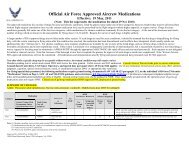
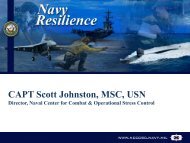
![Body Composition and Military [PDF] - Human Performance ...](https://img.yumpu.com/43269347/1/190x245/body-composition-and-military-pdf-human-performance-.jpg?quality=85)
![Tips for Grocery Shopping [PDF]](https://img.yumpu.com/37447379/1/190x245/tips-for-grocery-shopping-pdf.jpg?quality=85)
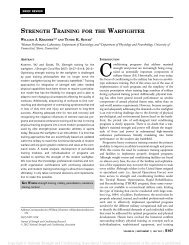
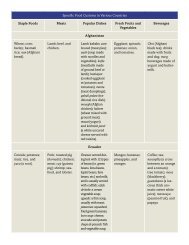
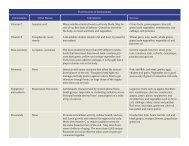
![Synthetic Drugs [PDF] - Human Performance Resource Center](https://img.yumpu.com/37447322/1/190x245/synthetic-drugs-pdf-human-performance-resource-center.jpg?quality=85)



